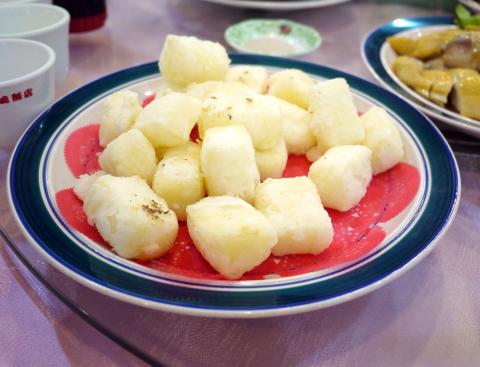Kouhsiangting (口香亭) is a second-generation restaurant serving up Yilan specialties within walking distance of the Yilan City train station. Run by “Mouth” (Chen Ching-chou, 陳慶洲, nicknamed after the first Chinese character in the restaurant’s name, kou, 口) and his wife Yang Mei-chen (楊美珍), Kouhsiangting offers up authentic Yilan cuisine and hospitality.
Founded 30 years ago, Kouhsiangting originally served only local dishes, but under Mouth’s stewardship the menu has expanded to include Japanese cuisine. Before taking over the family business, Mouth spent two years working in the Japanese enclave of Taipei’s Santiaotong area (三條通) to learn the art of Japanese cooking, but it is clear from his creative use of local ingredients and styles that his heart and soul are in Yilan.
The restaurant does a good rendition of a must-try Yilan specialty — gaozha (糕渣, NT$120). Based on gelatinous chicken soup, Kouhsiangting’s golden-fried gaozha nuggets are crispy on the outside with a comforting custardy filling inside. Gaozha is said to represent the spirit of the Yilan people — lukewarm on the outside but boiling hot within. And if the warm welcome my husband and I received at Kouhsiangting was anything to go by, this axiom certainly holds true.

Photo: S.J. Huang
Kouhsiangting specializes in fresh seafood, which is displayed in a glass case near the entrance to tempt patrons. We tried local red-headed silver carp (煎紅目鰱, seasonal price), which was steamed, garnished with soy sauce and decorated with fresh chilies and shallots that accentuated the natural sweetness of the fish. We also sampled a lightly flavored octopus rice vermicelli soup (小卷米粉, NT$150), topped with shaved bonito and packed with tender baby octopus and flecks of pastel-colored fishcake.
By far the most impressive dish was the teppanyaki-style pepper beef steak (西魯肉, NT$120), which was rushed to the table with flourish in a silver cloche. The bulging beef chunks and mountain mushrooms were coated in a thick, rich sauce and served next to crunchy strips of bell pepper.
I also enjoyed the sliced cold chicken (白斬雞, NT$200). Cleaved into large pieces, the yellow-skinned bird was unadorned and tasted the way you imagine real chicken did before the advent of mass production. (The yellow skin indicates the chicken was free-range.)

Photo: S.J. Huang
Vegetable dishes were not overlooked. I especially liked the robust stir-fried sugar-peas and mushrooms with pepper sauce (甜豆珍菇, NT$100), which reminded me of a vegetable version of the teppanyaki steak.

In the next few months tough decisions will need to be made by the Taiwan People’s Party (TPP) and their pan-blue allies in the Chinese Nationalist Party (KMT). It will reveal just how real their alliance is with actual power at stake. Party founder Ko Wen-je (柯文哲) faced these tough questions, which we explored in part one of this series, “Ko Wen-je, the KMT’s prickly ally,” (Aug. 16, page 12). Ko was open to cooperation, but on his terms. He openly fretted about being “swallowed up” by the KMT, and was keenly aware of the experience of the People’s First Party

Aug. 25 to Aug. 31 Although Mr. Lin (林) had been married to his Japanese wife for a decade, their union was never legally recognized — and even their daughter was officially deemed illegitimate. During the first half of Japanese rule in Taiwan, only marriages between Japanese men and Taiwanese women were valid, unless the Taiwanese husband formally joined a Japanese household. In 1920, Lin took his frustrations directly to the Ministry of Home Affairs: “Since Japan took possession of Taiwan, we have obeyed the government’s directives and committed ourselves to breaking old Qing-era customs. Yet ... our marriages remain unrecognized,

During the Metal Ages, prior to the arrival of the Dutch and Chinese, a great shift took place in indigenous material culture. Glass and agate beads, introduced after 400BC, completely replaced Taiwanese nephrite (jade) as the ornamental materials of choice, anthropologist Liu Jiun-Yu (劉俊昱) of the University of Washington wrote in a 2023 article. He added of the island’s modern indigenous peoples: “They are the descendants of prehistoric Formosans but have no nephrite-using cultures.” Moderns squint at that dynamic era of trade and cultural change through the mutually supporting lenses of later settler-colonialism and imperial power, which treated the indigenous as

Standing on top of a small mountain, Kim Seung-ho gazes out over an expanse of paddy fields glowing in their autumn gold, the ripening grains swaying gently in the wind. In the distance, North Korea stretches beyond the horizon. “It’s so peaceful,” says the director of the DMZ Ecology Research Institute. “Over there, it used to be an artillery range, but since they stopped firing, the nature has become so beautiful.” The land before him is the demilitarized zone, or DMZ, a strip of land that runs across the Korean peninsula, dividing North and South Korea roughly along the 38th parallel north. This